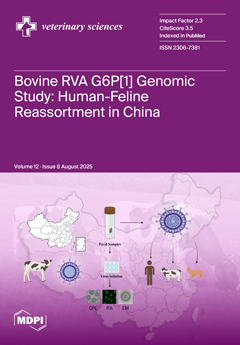White muscle disease (WMD) is a degenerative condition of the skeletal and/or cardiac muscle associated with selenium (Se) and/or vitamin E deficiency, which can present in acute, subacute, or chronic forms, and is most commonly observed in young, rapidly growing animals, though it
[...] Read more.
White muscle disease (WMD) is a degenerative condition of the skeletal and/or cardiac muscle associated with selenium (Se) and/or vitamin E deficiency, which can present in acute, subacute, or chronic forms, and is most commonly observed in young, rapidly growing animals, though it may also occur in older individuals. This study aims to determine the serum concentrations of galectin-3 (Gal-3), cardiac troponin I (cTnI), and N-terminal pro-brain natriuretic peptide (NT-proBNP), as well as the activity of creatine kinase-myocardial band (CK-MB), in lambs diagnosed with WMD, and to investigate the diagnostic potential of these biomarkers in the evaluation of myocardial injury and skeletal and/or cardiac muscle necrosis associated with WMD. A total of 50 lambs, 20 healthy and 30 with WMD, were included in the study. The diagnosis of WMD was made based on clinical signs, laboratory results, necropsy findings, and blood vitamin E and Se concentrations. The lambs in the WMD group were categorized into two subgroups: confirmed, severe aWMD (acute animals,
n = 10) lambs and presumed sWMD (subacute animals,
n = 20), based on the clinical progression and severity of the disease. Serum levels of NT-proBNP, Gal-3, and cTnI were assessed using the ELISA technique. Levels of cTnI and CK-MB indicative of myocardial injury were found to be considerably elevated in the aWMD group (
p < 0.001) in comparison to both the sWMD and control groups. CK-MB showed a strong positive correlation with cTnI (r = 0.819,
p < 0.001). The serum concentrations of Gal-3 and NT-proBNP in healthy lambs were 2.55 ± 0.52 ng/mL and 3.28 ± 0.71 ng/mL, respectively. Serum Gal-3 concentrations were measured as 2.99 ± 0.44 ng/mL in the aWMD group and 3.07 ± 0.42 ng/mL in the sWMD group, while NT-proBNP concentrations were 2.15 ± 0.32 ng/mL and 2.64 ± 0.55 ng/mL in the aWMD and sWMD groups, respectively. No statistically significant differences were found in serum Gal-3 or NT-proBNP levels among the three groups (
p > 0.05). In conclusion, this study is the first investigation assessing serum concentrations of Gal-3 and NT-proBNP in lambs afflicted with WMD. The results suggest that Gal-3 and NT-proBNP are ineffective biomarkers for assessing myocardial injury and skeletal and/or cardiac muscle necrosis associated with WMD in lambs. However, cTnI and CK-MB appear to be significant indicators of cardiac involvement in both acute and subacute scenarios. Further research is required to elucidate the molecular function of Gal-3 in muscle and cardiac disease in lambs afflicted with WMD.
Full article






